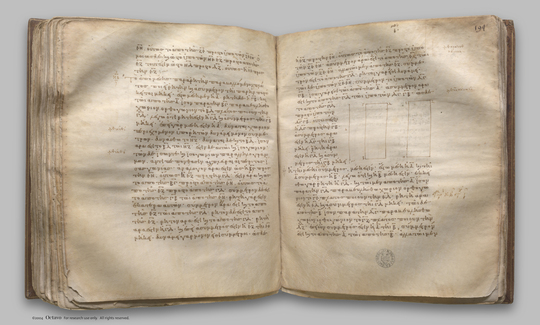index prev next | digilib folio 198

The square on a medial straight line, if applied to a rational straight line, produces as breadth a straight line rational and incommensurable in length with that to which it is applied.
| Τὸ ἀπὸ μέσης παρὰ ῥητὴν παραβαλλόμενον πλάτος ποιεῖ ῥητὴν καὶ ἀσύμμετρον τῇ, παρ' ἣν παράκειται, μήκει. Ἔστω μέση μὲν ἡ Α, ῥητὴ δὲ ἡ ΓΒ, καὶ τῷ ἀπὸ τῆς Α ἴσον παρὰ τὴν ΒΓ παραβεβλήσθω χωρίον ὀρθογώνιον τὸ ΒΔ πλάτος ποιοῦν τὴν ΓΔ: λέγω, ὅτι ῥητή ἐστιν ἡ ΓΔ καὶ ἀσύμμετρος τῇ ΓΒ μήκει. Ἐπεὶ γὰρ μέση ἐστὶν ἡ Α, δύναται χωρίον περιεχόμενον ὑπὸ ῥητῶν δυνάμει μόνον συμμέτρων. δυνάσθω τὸ ΗΖ. δύναται δὲ καὶ τὸ ΒΔ: ἴσον ἄρα ἐστὶ τὸ ΒΔ τῷ ΗΖ. ἔστι δὲ αὐτῷ καὶ ἰσογώνιον: τῶν δὲ ἴσων τε καὶ ἰσογωνίων παραλληλογράμμων ἀντιπεπόνθασιν αἱ πλευραὶ αἱ περὶ τὰς ἴσας γωνίας: ἀνάλογον ἄρα ἐστὶν ὡς ἡ ΒΓ πρὸς τὴν ΕΗ, οὕτως ἡ ΕΖ πρὸς τὴν ΓΔ. ἔστιν ἄρα καὶ ὡς τὸ ἀπὸ τῆς ΒΓ πρὸς τὸ ἀπὸ τῆς ΕΗ, οὕτως τὸ ἀπὸ τῆς ΕΖ πρὸς τὸ ἀπὸ τῆς ΓΔ. σύμμετρον δέ ἐστι τὸ ἀπὸ τῆς ΓΒ τῷ ἀπὸ τῆς ΕΗ: ῥητὴ γάρ ἐστιν ἑκατέρα αὐτῶν: σύμμετρον ἄρα ἐστὶ καὶ τὸ ἀπὸ τῆς ΕΖ τῷ ἀπὸ τῆς ΓΔ. ῥητὸν δέ ἐστι τὸ ἀπὸ τῆς ΕΖ: ῥητὸν ἄρα ἐστὶ καὶ τὸ ἀπὸ τῆς ΓΔ: ῥητὴ ἄρα ἐστὶν ἡ ΓΔ. καὶ ἐπεὶ ἀσύμμετρός ἐστιν ἡ ΕΖ τῇ ΕΗ μήκει: δυνάμει γὰρ μόνον εἰσὶ σύμμετροι: ὡς δὲ ἡ ΕΖ πρὸς τὴν ΕΗ, οὕτως τὸ ἀπὸ τῆς ΕΖ πρὸς τὸ ὑπὸ τῶν ΖΕ, ΕΗ, ἀσύμμετρον ἄρα [ ἐστὶ ] τὸ ἀπὸ τῆς ΕΖ τῷ ὑπὸ τῶν ΖΕ, ΕΗ. ἀλλὰ τῷ μὲν ἀπὸ τῆς ΕΖ σύμμετρόν ἐστι τὸ ἀπὸ τῆς ΓΔ: ῥηταὶ γάρ εἰσι δυνάμει: τῷ δὲ ὑπὸ τῶν ΖΕ, ΕΗ σύμμετρόν ἐστι τὸ ὑπὸ τῶν ΑΓ, ΓΒ: ἴσα γάρ ἐστι τῷ ἀπὸ τῆς Α: ἀσύμμετρον ἄρα ἐστὶ καὶ τὸ ἀπὸ τῆς ΓΔ τῷ ὑπὸ τῶν ΔΓ, ΓΒ. ὡς δὲ τὸ ἀπὸ τῆς ΓΔ πρὸς τὸ ὑπὸ τῶν ΔΓ, ΓΒ, οὕτως ἐστὶν ἡ ΔΓ πρὸς τὴν ΓΒ: ἀσύμμετρος ἄρα ἐστὶν ἡ ΔΓ τῇ ΓΒ μήκει. ῥητὴ ἄρα ἐστὶν ἡ ΓΔ καὶ ἀσύμμετρος τῇ ΓΒ μήκει: ὅπερ ἔδει δεῖξαι. | The square on a medial straight line, if applied to a rational straight line, produces as breadth a straight line rational and incommensurable in length with that to which it is applied. Let A be medial and CB rational, and let a rectangular area BD equal to the square on A be applied to BC, producing CD as breadth; I say that CD is rational and incommensurable in length with CB. For, since A is medial, the square on it is equal to a rectangular area contained by rational straight lines commensurable in square only. [X. 21] Let the square on it be equal to GF. But the square on it is also equal to BD; therefore BD is equal to GF. But it is also equiangular with it; and in equal and equiangular parallelograms the sides about the equal angles are reciprocally proportional; [VI. 14] therefore, proportionally, as BC is to EG, so is EF to CD. Therefore also, as the square on BC is to the square on EG, so is the square on EF to the square on CD. [VI. 22] But the square on CB is commensurable with the square on EG, for each of these straight lines is rational; therefore the square on EF is also commensurable with the square on CD. [X. 11] But the square on EF is rational; therefore the square on CD is also rational; [X. Def. 4] therefore CD is rational. And, since EF is incommensurable in length with EG, for they are commensurable in square only, and, as EF is to EG, so is the square on EF to the rectangle FE, EG, [Lemma] therefore the square on EF is incommensurable with the rectangle FE, EG. [X. 11] But the square on CD is commensurable with the square on EF, for the straight lines are rational in square; and the rectangle DC, CB is commensurable with the rectangle FE, EG, for they are equal to the square on A; therefore the square on CD is also incommensurable with the rectangle DC, CB. [X. 13] But, as the square on CD is to the rectangle DC, CB, so is DC to CB; [Lemma] therefore DC is incommensurable in length with CB. [X. 11] |